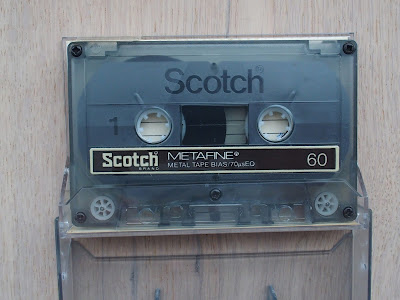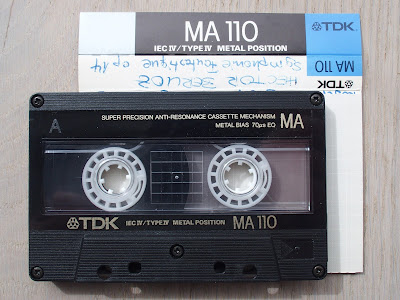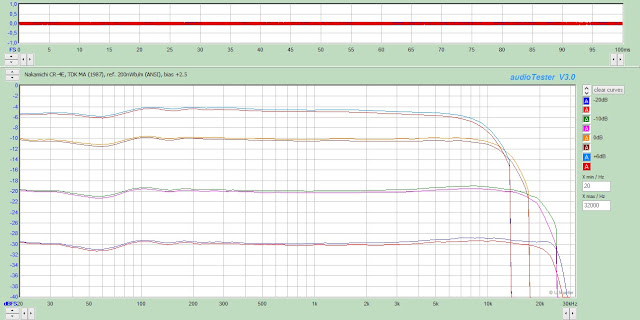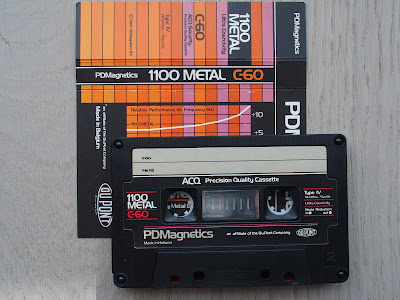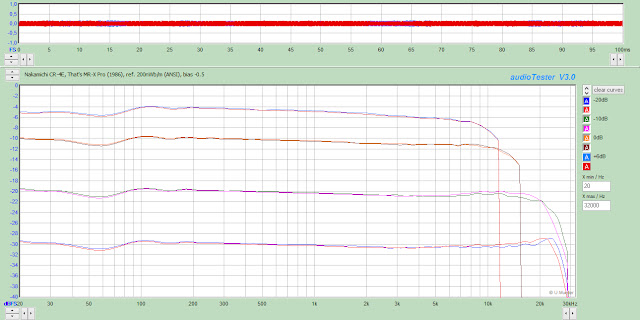The original version of this article, still accessible at the bottom of this page, used a Nakamichi Cassette Deck 1. In these old tests, the tapes' Maximum Output Level (400Hz) and Saturated Output Level (10kHz) were referred to the input signal, after compensation for the tapes' sensitivities. In later instalments I changed over to the more correct method of referring all tape parameters to the output levels. I also started using a Nakamichi BX-300, if only because the CD1 was sited permanently in the music system. Due to differences in bias and record equalisation approaches, however, this BX-300 showed a larger MOL for type I tapes than the CD1, which I liked, and a lower MOL for type IV metals, which is bad.
During 2018 I obtained a CR-3 and a CR-4. Both late production, i.e. with the increased playback time constants to compensate for the slightly inferior heads (compared to classic Naks). Both these decks showed low MOL on type II and type IV. Apparently Nakamichi had decided to under-bias their machines, in order to achieve the widest-possible frequency responses at all recording levels (for example, the CR-3 went out to 27kHz at -20dB!). I can only assume that this move was inspired by the arrival of DAT and the wide-spread use of Dolby C. Sadly, this move went at the cost of dynamic range, in case no noise reduction was used.
I refurbished and sold the CR-3, then I refurbished the CR-4, for my own use. As I don't use NR (I am expecting compatibility problems in the future, when less and less correctly-working decks will be around), I wanted to regain that missing dynamic range. So I modified the CR-4's recording equaliser to boost the treble by 1.5dB above 3kHz or so, forcing a concomitant raise in bias current to flatten out the response again. This turned the CR-4 more or less into an equivalent of my Cassette Deck 1, when it comes to output levels and frequency responses. I will now use this CR-4 for testing metal tapes, and the BX-300 for testing type I and II tapes.
One tape that I have and that is conspicuously missing is the grand TDK MA-XG (1990). I obtained a new, sealed sample end of 2020 and ran some preliminary tests in the CR-4. The first tens of cms on each side were curiously pitted. The tape was very prone to instant railroading and scratching. Then I noted a minor amount of the dreaded white dust syndrome on the B-side tape pack. In other words: not safe for use. What I did glean is this: bias had to be increased and level reduced a lot, for a metal tape. The resultant frequency response had a weird 2dB dip around 4kHz. MOL was staggering, at least +10dB, while bias noise was a low -58dB(A). That gives a dynamic range of over 68dB, the highest I have ever seen (to that date). So sad then that the mechanical and chemical properties of this tape are totally letting it down!
For a detailed overview of the test methods look here, substituting CR-4 for BX-300.
INDEX OF ALL CASSETTES
Sony Metal XR (1995) (alignment reference)
Relative bias: (reference)Relative sensitivity: (reference)
THD @ Dolby level: 0.69%
MOL400(THD=1%) : +2.4dB
MOL400(THD=3%): +7.4dB
MOL1k(THD=3%): +7.7dB
SOL10k: +0.5dB
Bias noise: -53.4dB, -57.4dB(A)
Dynamic range: 64.8dB
Metal XR was launched as one of the first budget metals in 1990. Price-wise it could compete with the higher-end type IIs. I had quite a few of the original XRs (not that my CR-2 really could exploit them: its MOL limits at +2dB). I still have some unused ones of the 1995 variety, so this is what I align my decks to today. The dynamic range is close to 65dB, which is good, but really not better than what the best type IIs (SA-X, XLII-S, TPII) manage, and it requires a deck that can drive the tape to high levels. Treble extension, of course, is superior to the type IIs.
Sony Metal XR (1989)
Relative bias: 0Relative sensitivity: 0dB
THD @ Dolby level: 0.73%
MOL400(1%) : +1.9dB
MOL400(3%): +7.1dB
MOL1k(3%): +7.4dB
SOL10k: +0.4dB
Bias noise: -52.8dB, -56.9dB(A)
Dynamic range: 64.0dB
The original XR hardly differs from the 1995 version. Overall dynamic range is 1dB less.
Sony Metal XR (1992)
Relative bias: +1
Relative sensitivity: -0.4dB
THD @ Dolby level: 0.75%
MOL400(1%) : +1.7dB
MOL400(3%): +7.0dB
MOL1k(3%): +7.3dB
SOL10k: 0dB
Bias noise: -53.1dB, -57.4dB(A)
Dynamic range: 64.4dB
The second-generation XR showed slightly reduced noise, but was not fully compatible with the versions that came before and after. However, according to a contemporary HiFi Choice test it is very close to IEC type IV standard MJ507A.
Sony Metal ES (1986)
Relative bias: +2Relative sensitivity: +1.2dB
THD @ Dolby level: 0.29%
MOL400(1%) : +6.2dB
MOL400(3%): +10.0dB
MOL1k(3%): +9.2dB
SOL10k: -0.2dB
Bias noise: -53.7dB, -58.4dB(A)
Dynamic range: 68.4dB
I got this cassette from a Tapeheads member, in summer 2021. He said that, while worn, it would be 'interesting'. And it is: a record performance in terms of distortion, MOLs, and dynamic range. Sadly the frequency response is dished, much like the TDK MA-XG, almost begging for a recorder with adjustable equalisation. Imagine this tape, combined with a Nakamichi 1000ZXL ...
Hitachi ME (1979)
Relative bias: -1.5Relative sensitivity: +0.3dB
THD @ Dolby level: 0.50%
MOL400(1%) : +3.4dB
MOL400(3%): +8.1dB
MOL1k(3%): +8.2dB
SOL10k: +0.5dB
Bias noise: -50.3dB, -53.3dB(A)
Dynamic range: 61.4dB
Hitachi ME (1981)
Relative bias: -1.5
Relative sensitivity: -0.1dB
THD @ Dolby level: 0.72%
MOL400(1%) : +1.8dB
MOL400(3%): +6.7dB
MOL1k(3%): +8.1dB
SOL10k: +0.4dB
Bias noise: -50.7dB, -53.7dB(A)
Dynamic range: 60.4dB
Curiously it does not match its older sibling, or 1980 MX, in distortion, and thus in dynamic range. The 1982 Fono Forum test also found ME to be inferior to MX, while a lot more expensive!
Maxell MX (1979)
Relative bias: -1.5Relative sensitivity: -0.1dB
THD @ Dolby level: 0.65%
MOL400(1%) : +2.2dB
MOL400(3%): +6.9dB
MOL1k(3%): +7.7dB
SOL10k: 0dB
Bias noise: -50.4dB, -53.6dB(A)
Dynamic range: 60.5dB
Maxell MX (1980)
Relative bias: 0Relative sensitivity: +0.3dB
THD @ Dolby level: 0.47%
MOL400(1%) : +4.1dB
MOL400(3%): +8.6dB
MOL1k(3%): +9.3dB
SOL10k: +1.1dB
Bias noise: -49.3dB, -52.5dB(A)
Dynamic range: 61.1dB
Maxell's second generation of metal tape. Output levels are very high, but noise is high too. In fact, noise is at the level of a late good budget ferric, like UR, and that's then with 4dB of help from metal's 70 microsecond playback equalisation!
Maxell MX (1982)
Relative bias: 0Relative sensitivity: 0dB
THD @ Dolby level: 0.65%
MOL400(1%) : +2.4dB
MOL400(3%): +7.3dB
MOL1k(3%): +8.3dB
SOL10k: +0.9dB
Bias noise: -51.3dB, -54.9dB(A)
Dynamic range: 62.2dB
Noise improved, but maximum output levels dropped.
Maxell MX (1985)
Relative bias:0Relative sensitivity: +0.4dB
THD @ Dolby level: 0.50%
MOL400(1%) : +3.6dB
MOL400(3%): +8.4dB
MOL1k(3%): +9.2dB
SOL10k: +1.1dB
Bias noise: -50.5dB, -54.1dB(A)
Dynamic range: 62.5dB
Maxell MX (1986)
Relative bias: +1Relative sensitivity: -0.8dB
THD @ Dolby level: 0.81%
MOL400(1%) : +1.0dB
MOL400(3%): +6.0dB
MOL1k(3%): +6.8dB
SOL10k: 0.3dB
Bias noise: -52.5dB, -56.5dB(A)
Dynamic range: 62.5dB
A significant reduction in noise is accompanied with a just as significant reduction in MOL. But of course this made the tape more useful in decks that could not record very high levels.
Maxell MX (1990)
Relative bias: +1Relative sensitivity: -0.7dB
THD @ Dolby level: 0.68%
MOL400(1%) : +1.4dB
MOL400(3%): +6.3dB
MOL1k(3%): +6.9dB
SOL10k: -0.1dB
Bias noise: -53.1dB, -57.2dB(A)
Dynamic range: 63.5dB
The story goes that at this time the 'MX' type designation was renamed 'MX-S', and a new, budget metal tape was introduced under the 'MX' name. This particular tape was a passer-by, coming with a deck I had to align for someone. Sadly it was worn, with the right channel tracking badly most of the time. Looking at the left channel, however, shows that it inherited the settings of the 1986 MX, while offering slightly better MOL and noise. This MX certainly was not a step back, and is overall comparable to Sony XR in quality.
Maxell MX-S (1992)
Relative bias: +4Relative sensitivity: -1.6dB
THD @ Dolby level: 0.81%
MOL400(1%) : +1.2dB
MOL400(3%): +6.0dB
MOL1k(3%): +7.2dB
SOL10k: -0.4dB
Bias noise: -52.1dB, -56.4dB(A)
Dynamic range: 62.4dB
This somewhat worn sample actually had a December 1991 date code. Bias had to be increased to flatten a huge treble peak, while sensitivity remained low. Disappointingly, its performance does not even reach that of 1990's MX. Allowing for wide lot variation (also disappointingly) the tape may be the same as 1990, or maybe even 1986?
Scotch Metafine (1979)
Relative bias: -2.5Relative sensitivity: 0dB
THD @ Dolby level: 0.95%
MOL400(1%) : +0.5dB
MOL400(3%): +5.5dB
MOL1k(3%): +5.6dB
SOL10k: -1.1dB
Bias noise: -53.1dB, -56.7dB(A)
Dynamic range: 62.3dB
Early 1979 Philips launched the first metal tape, after a couple of years of heated anticipation, only to withdraw it right away when critical voices opined that it did not quite deliver on its promises. Months after that Scotch came with Metafine and thus got to be the first really available metal.
I purchased mine late in 1985, it must have been a long time on the shop's shelf. I used it for mastering the one music production I've ever made myself (hired hands - I am not a musician - TEAC 144 Portastudio with XLII, Technics RS-M250 for mixdown, Korg Polysix, Yamaha DX-7, ARP Odyssey, Roland Space Echo). Compared to the somewhat more recent Maxell MX it requires a much lower bias, returns lower maximum output levels, but also boasts an impressively lower noise! This ties in with a Hi-Fi Choice review of 1981, which by the way criticised Metafine for consistently having poor stability and drop-outs.
BASF Metal Maxima TPIV (1995)
Relative bias: +1Relative sensitivity: +0.5dB
THD @ Dolby level: 0.44%
MOL400(1%) : +4.5dB
MOL400(3%): +9.0dB
MOL1k(3%): +9.5dB
SOL10k: +0.8dB
Bias noise: -53.0dB, -56.9dB(A)
Dynamic range: 65.9dB
This one is a bit puzzling. I found it in a batch of used tapes, without its proper inlay (the inlay in the picture is a DIY copy of the 1995 version). The shell has an imprint very similar to the first TPII of 1993, but the cassette's spine code gives 1995. This is in line with internet sources putting the first TPIV in that year, but with 'Fantastic Sound for CD' written all over it. Let's assume that it simply is a very early sample. The tape itself is, allegedly, Maxell MX or MX-S. Staggering MOL, decent-enough noise, and then that fantastic shell. I wish I had more of these!
Fuji FR Metal (1982)
Relative bias: +1Relative sensitivity: -0.15dB
THD @ Dolby level: 0.53%
MOL400(1%) : +3.6dB
MOL400(3%): +8.2dB
MOL1k(3%): +8.7dB
SOL10k: +0.1dB
Bias noise: -51.3dB, -55.0dB(A)
Dynamic range: 63.2dB
TDK MA (1989)
Relative bias: +2.5Relative sensitivity: -0.8dB
THD @ Dolby level: 0.73%
MOL400(1%) : +1.6dB
MOL400(3%): +7.4dB
MOL1k(3%): +8.9dB
SOL10k: +0.4dB
Bias noise: -52.9dB, -56.8dB(A)
Dynamic range: 64.2dB
TDK CDing Metal (1994)
Relative bias: +2Relative sensitivity: -0.1dB
THD @ Dolby level: 0.60%
MOL400(1%) : +2.9dB
MOL400(3%): +7.6dB
MOL1k(3%): +9.0dB
SOL10k: +0.4dB
Bias noise: -52.8dB, -56.7dB(A)
Dynamic range: 64.3dB
PDM 1100 Metal (1981)
Relative bias: -0.5Relative sensitivity: -0.5dB
THD @ Dolby level: 0.67%
MOL400(1%) : +2.5dB
MOL400(3%): +7.1dB
MOL1k(3%): +7.8dB
SOL10k: +1.0dB
Bias noise: -50.2dB, -53.5dB(A)
Dynamic range: 60.6dB
Agfa Metal (1979)
Relative sensitivity: +0.2dB
THD @ Dolby level: 0.8%
MOL400(1%) : +1.3dB
MOL400(3%): +5.8dB
MOL1k(3%): +6.8dB
SOL10k: -0.1dB
Bias noise: -51.3dB, -54.8dB(A)
Dynamic range: 60.6dB
Not in the best shape. After the measurements run the tape guide and erase head were clogged with a white residue, presumably binder. It took a lot of cotton swabs, IPA, and even acetone (on the head) to get things clean again.
That's MR (1983)
Relative bias: 0Relative sensitivity: +0.6dB
THD @ Dolby level: 0.45%
MOL400(1%) : +3.7dB
MOL400(3%): +8.0dB
MOL1k(3%): +8.8dB
SOL10k: +0.6dB
Bias noise: -52.1dB, -55.5dB(A)
Dynamic range: 63.5dB
That's MR-X Pro (1986)
Relative bias: -0.5Relative sensitivity: +0.6dB
THD @ Dolby level: 0.51%
MOL400(1%) : +3.4dB
MOL400(3%): +7.8dB
MOL1k(3%): +8.3dB
SOL10k: +0.1dB
Bias noise: -52.0dB, -55.3dB(A)
Dynamic range: 63.1dB
Various websites put this variant in 1985 or in 1987. Yet, it features in magazine reviews from the period 1986-1989. The tape itself is probably the same as the older MR.
INDEX OF ALL CASSETTES



























